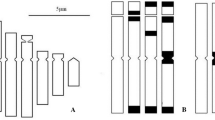Abstract
Hypotheses on the evolution of the karyotypes of 8 chromosome races (2n = 4, 6, 8, 10, 12, 16-two forms, 26) within theOrnithogalum tenuifolium complex are discussed. Four of the karyotypes are strictly bimodal: 2n = 8 (6 long and two short chromosomes), 2n = 10 (6 long and 4 short chromosomes), 2n = 12 (6 long and 6 short chromosomes) and 2n = 16 (12 long and 4 short chromosomes). The hypotheses are tested by means of measurements of nuclear DNA content, studies of meiosis and pollen fertility of hybrids, and comparisons of karyotype morphology. The results indicate that the E. African 2n = 12 chromosome race is the most primitive and has given rise to the other chromosome races. The 2n = 6 race is found to have a significantly higher fitness than the 2n = 12 race.
Similar content being viewed by others
References
Bennett, M. D., Smith, J. B., 1976: Nuclear DNA amounts in Angiosperms. — Philos. Trans. Roy. Soc. London B274: 227–274.
Brandham, P. E., 1983: Evolution in a stable chromosome system. — InBrandham, P. E., Bennett, M. D., (Eds.): Kew chromosome conference 2, pp. 251–260. — London: George Allen & Unwin.
Conover, W. J., 1980: Practical nonparametric statistics. 2nd edn. — New York: Wiley.
Darlington, C. D., 1963: Chromosome botany and the origins of cultivated plants. — New York: Hafner, and London: Geore Allen & Unwin.
Kenton, A. Y., Rudall, P. J., Johnson, A. R., 1986: Genome size variation inSisyrinchium L. (Iridaceae) and its relationships to phenotype and habitat. — Bot. Gaz.147: 342–354.
Levitsky, G. A., 1931: The karyotype in systematics. — Bull. Appl. Bot. Genet. Pl. Breed.27: 220–240.
Obermeyer, A. A., 1978:Ornithogalum: a revision of the southern African species. — Bothalia12: 323–376.
Solbrig, O. T., Solbrig, D. J., 1984: Size inequalities and fitness in plant populations. — InDawkins, R., Ridley, M., (Eds.): Oxford surveys in evolutionary biology 1. — Oxford: Oxford University Press.
Stebbins, G. L., 1971: Chromosomal evolution in higher plants. — London: Edward Arnold.
Stedje, B., 1988: A new low chromosome number forOrnithogalum tenuifolium. — Pl. Syst. Evol.161: 65–69.
—,Nordal, I., 1984: Taxonomy and cytology of the genusOrnithogalum (Liliaceae) in East Africa. — Nordic J. Bot.4: 749–759.
—, —, 1987: Cytogeographical studies ofHyacinthaceae in Africa south of the Sahara. — Nordic J. Bot.7: 53–65.
Vosa, C. G., 1983: Chromosome evolution inOrnithogalum. — InBrandham, P. E., Bennett, M. D., (Eds.): Kew chromosome conference 2, p. 370. — London: George Allen & Unwin.
Author information
Authors and Affiliations
Rights and permissions
About this article
Cite this article
Stedje, B. Chromosome evolution within theOrnithogalum tenuifolium complex (Hyacinthaceae), with special emphasis on the evolution of bimodal karyotypes. Pl Syst Evol 166, 79–89 (1989). https://doi.org/10.1007/BF00937877
Received:
Issue Date:
DOI: https://doi.org/10.1007/BF00937877




